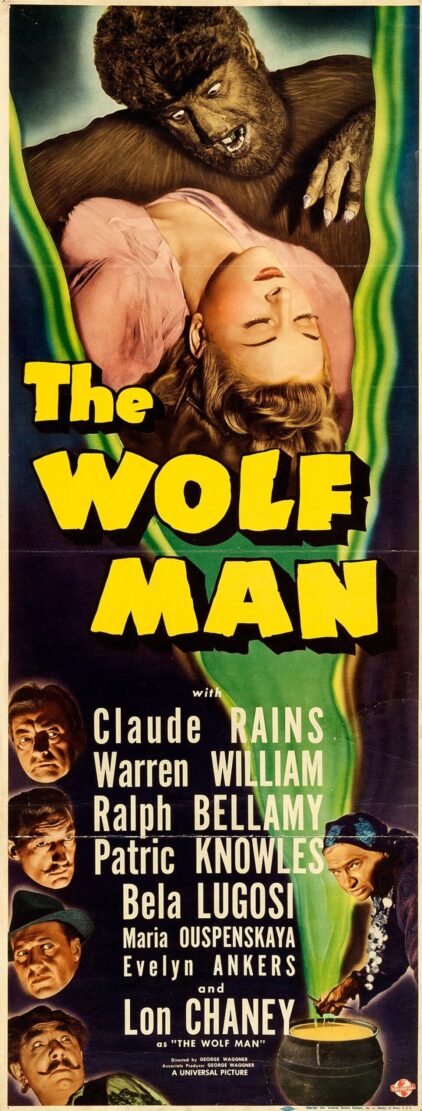 This 1941 classic is not merely the most famous werewolf movie ever made, but also the source for much modern-day werewolf lore. It’s one of Universal’s “Big Five” golden age horror releases (the others being FRANKENSTEIN, DRACULA, THE MUMMY and THE CREATURE FROM THE BLACK LAGOON), with some major names associated with it: Lon Chaney Jr. in his most iconic role, Claude Rains (the Invisible Man himself), Bela Lugosi (a.k.a. Dracula) and screenwriter Curt Siodmak, whose imagination was at full boil.
This 1941 classic is not merely the most famous werewolf movie ever made, but also the source for much modern-day werewolf lore. It’s one of Universal’s “Big Five” golden age horror releases (the others being FRANKENSTEIN, DRACULA, THE MUMMY and THE CREATURE FROM THE BLACK LAGOON), with some major names associated with it: Lon Chaney Jr. in his most iconic role, Claude Rains (the Invisible Man himself), Bela Lugosi (a.k.a. Dracula) and screenwriter Curt Siodmak, whose imagination was at full boil.
…one of Universal’s “Big Five” golden age horror releases…
Larry Talbot (Chaney) has been away from his ancestral home in Wales, to which he’s returned due to the death of his twin brother in a hunting accident. From a pretty antique shop clerk named Gwynn Conliffe (Universal horror staple Evelyn Ankers) Larry learns of the legend of the werewolf—knowledge that proves useful when Jenny (Fay Helm), a young acquaintance, is attacked by just such a wolf (actually Lon Chaney Jr.’s pet German shepherd). Larry kills the animal, but not until after he’s bitten on the chest. The following day a dead gypsy fortune teller is found in the wolf’s place, while the wound on Larry’s chest has inexplicably healed up.
Speaking of Larry, Gwen’s suitor Frank (Patric Knowles) warns her that “there’s something very tragic about that man, and I’m sure that nothing but harm will come to you through him.” Larry is confronted by a relative (Maria Ouspenskaya) of the murdered gypsy woman, who lays out three rules that have resonated far beyond this film: 1). that a werewolf can only be killed with a silver bullet (or a knife or stick with a silver handle), 2). that a pentagram, the sign of the wolf, can break the spell, and 3). that “Whoever is bitten by a werewolf and lives becomes a werewolf himself.”
That night Larry proves claim #3 by sprouting hair all over his body and, in a dash through a cemetery, killing a grave digger—and, on a second nocturnal hunt the following evening, gets his right foot caught in a trap. Larry tries to find solace with his father (Rains), who doesn’t believe his son is actually a werewolf, and ties him to a chair by a window so he can view the “real” wolf hunted down and shot—which is what ultimately happens.
This film is “stagey” in every sense of the word. The scenery, filmed on sets recognizable from THE HUNCHBACK OF NOTRE DAME and FRANKENSTEIN, fails to convince, and the performances seem more suited to the stage (there’s also the fact that the setting is Wales yet nobody speaks with an appropriate accent). The once-startling special effects, consisting of a succession of dissolves showing Lon Chaney Jr.’s face and body becoming progressively hairy (matted with yak fur and kelp), are no longer very affecting, and the sight of the not-very-wolf-like hunched-over title character doesn’t inspire much fear these days. The direction of George Waggner is, in contrast to that of the vigorous and imaginative helming by Universal directors like Tod Browning, James Whale and Robert Florey, pretty pedestrian; THE WOLF MAN was one of four movies made in 1941 by Waggner, and it’s no coincidence that he spent much of the remainder of his career working in television.
The one aspect that retains its effectiveness is the performance of Lon Chaney Jr., in a role he termed “my baby.” He communicates a sense of sadness and regret that feels authentic, and closes the film out on a powerfully tragic note.
Vital Statistics
THE WOLF MAN
Universal Pictures
Director/Producer: George Waggner
Screenplay: Curt Siodmak
Cinematography: Joseph Valent
Editing: Ted Kent
Cast: Lon Chaney Jr., Claude Rains, Warren Miller, Ralph Bellamy, Patric Knowles, Bela Lugosi, Maria Ouspenskaya, Evelyn Ankers, J.M. Kerrigan, Fay Helm, Forrester Harvey
